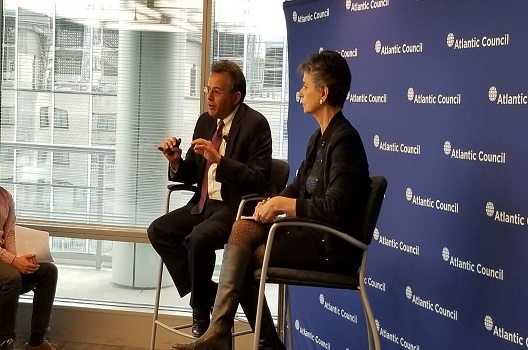 Iran’s political elite is “graying” and the average age of its members exceeds 55 in the cabinet and 65 in clerical-led institutions, according to Mehrzad Boroujerdi, a professor of political science at Syracuse University and co-author of an upcoming new book, Post-Revolutionary Iran: A Handbook.
Iran’s political elite is “graying” and the average age of its members exceeds 55 in the cabinet and 65 in clerical-led institutions, according to Mehrzad Boroujerdi, a professor of political science at Syracuse University and co-author of an upcoming new book, Post-Revolutionary Iran: A Handbook.
Boroujerdi, who spoke March 12 at an event hosted by the Atlantic Council’s Future of Iran initiative, said the median age in the cabinet of President Hassan Rouhani is 57 – compared to 38 in cabinets just following the 1979 Islamic revolution. The average age of members of the Guardian Council, a cleric-led body that vets all candidates for elected office, is 66 and the figure for the Assembly of Experts – clerics who nominally supervise Iran’s Supreme Leader – is 68. Supreme Leader Ayatollah Ali Khamenei is 78.
While age and incumbency rates are high for clerical-led bodies, Boroujerdi noted that there is much more turnover in Iran’s parliament, which is directly elected. The incumbency figure there is 33 percent, he said, compared to 80 percent in the US Congress.
Boroujerdi’s book, the first major comprehensive and empirical study of the post-revolutionary Iranian political elite, documents the positions held by more than 2000 individuals who rose to prominence after 1979. Most came from modest backgrounds and were children of clergy, farmers and small landowners and traders in the bazaar. Despite the dominant role of clerics in post-revolutionary Iran, the percentage of clergy in the government has been steadily dropping in favor of members of the Revolutionary Guards, particularly Iraq war veterans. Only 3.2 percent of the elite are female even though women comprise 60 percent of university students.
The book, co-authored with Kourosh Rahimkhani, took 14 years to assemble. It catalogs the Iranian elite’s social and regional origins, ideological orientations and positions held within the Islamic Republic over the past four decades covering 36 national elections from 1979 to 2017, including ministers in 15 different cabinets, members of 10 parliaments, 400 “legal and outlawed” political parties, and nepotism ties. Boroujerdi said 21 individuals had served in 10 or more positions and that about two dozen men comprise the core of power in the Islamic Republic.
Among other key findings: there has been no Sunni minister, vice president or representation in the Expediency Council, which mediates disputes among government branches, or the Guardian Council. Only 12 of 267 of members of the Assembly of Experts and 81 out of 1,812 parliamentarians have been Sunni, predominantly from Kurdistan and Sistan and Baluchistan provinces.
While women have also faced discrimination in terms of participation in the cabinet and other key bodies, nine of 46 vice presidents have been women. Since parliament does not have to approve these appointments, “the President can assign that to a woman as a token of gender equality,” Boroujerdi said. In general, women comprise only about 15 percent of the labor force – the same percentage as in 1978 — despite their academic achievements.
Asked about the recent outbreak of protests in Iran, Boroujerdi said they reflected a deep crisis in the banking system as well as serious environmental problems. Two things in Iran are certain, he said: “earthquakes and political unrest.” Whatever happens, Boroujerdi added, the Revolutionary Guards are likely to be the beneficiaries because of their access to financial and other resources.
